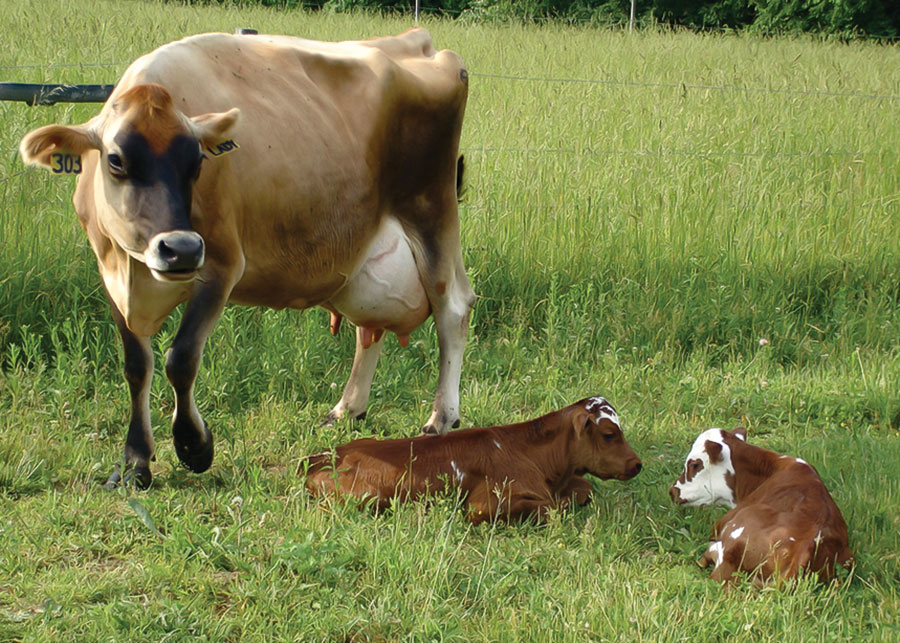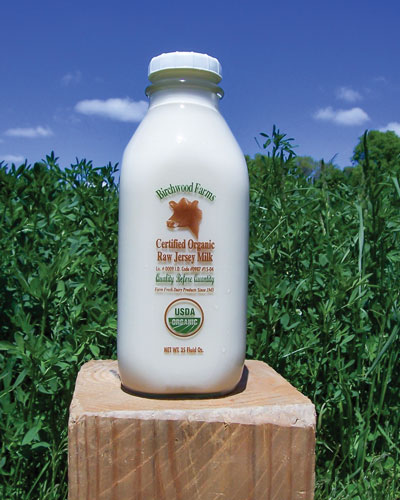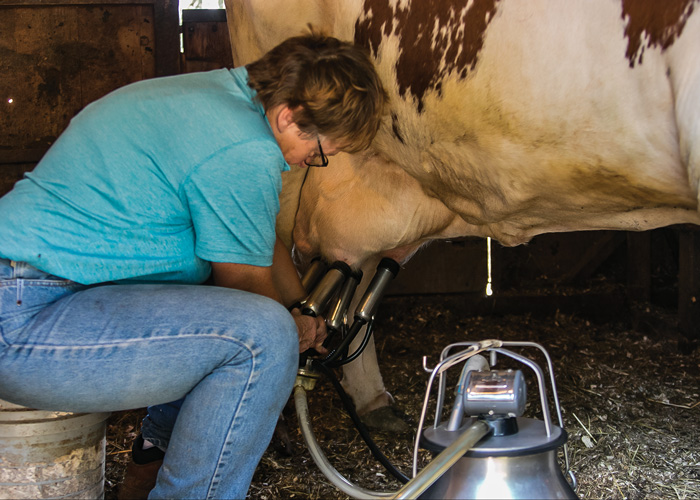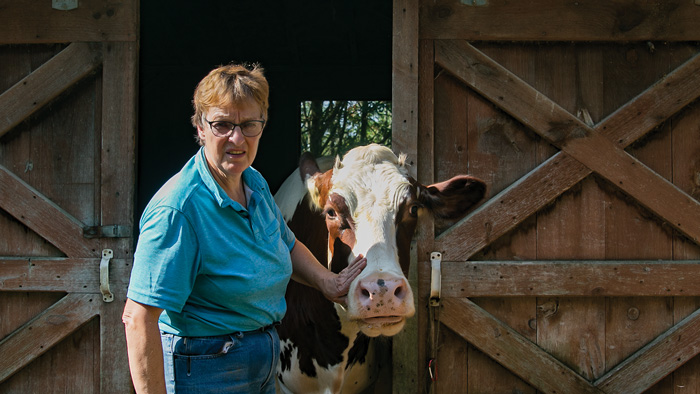Many states have adopted regulations to allow consumer access to carefully produced fresh, unprocessed whole milk. New Jersey is the only state with a complete prohibition against distribution of “raw” milk according to the Farm to Consumer Legal Defense Fund.

Just a few decades ago hundreds of dairy farms created a beautiful patchwork of pastoral landscapes interspersed with a cornucopia of horticultural crops that put the “Garden” in our state nickname. The Garden State is still blessed with many good soils capable of supporting a highly diversified agriculture, but it should include dairy for sustainability. With reforms in food policy we can reverse current trends that endanger the viability of small local dairy farming.
From my thirty years of work in New Jersey as a soil scientist, I have noted that the most fertile farm soils are associated with dairy. It is well documented that perennial forage crops and livestock pastures naturally build soil quality and organic matter content better than almost any other kind of farming. Soil fertility built up from dairy farming can support many other types of agricultural production when mixed into a well-designed ecological crop rotation.
Over the last couple of decades there has been a major consolidation of the industry into mega-dairy farms, with herd sizes ranging from 2,000 to 25,000 cows. These large-scale farms produce a cheap commodity milk with no special direct connection between the customer and the farmer. Commodity milk — pasteurized and homogenized and commingled from many farm sources — is the antithesis of artisan food. Factors that are known to influence milk quality and taste include breed of cow, type of feed, pasture raised or confinement, milking system, and farmer talent. These aspects are given little consideration when the main concerns in industrial systems are scale, quantity, and cheap food.
In the Garden State we have numerous thriving fruit and vegetable farmers who market directly to customers who are free to seek out produce based on how it was grown — organic or conventional — or by heirloom variety of tomato, sweet corn, etc. But such direct farm connections have disappeared for customers that seek fresh unprocessed milk. Folks who fondly remember the old days recall what it was like to taste fresh milk from specific farms each with their own unique set of production practices.
With the transformation of milk into a highly processed commodity, it should not come as a surprise that over the last four decades there has been a steady decline in per capita demand for drinking milk. In contrast, the demand for local fresh unprocessed, or “raw”, milk is strong. One survey designed to determine why people choose to drink raw milk found that the main reason is taste. Many people have moved to New Jersey here from other places where raw milk is readily available. In Europe, fresh unprocessed milk can be purchased from on-farm raw milk vending machines. New Jersey dairy farmers know the demand is significant because people reportedly keep showing up at the farm gate asking for raw milk.

Because of a 1964 law that prohibits sale of raw milk, New Jersey farmers are in a disadvantaged market position compared to dairies in most other states. The Pennsylvania Department of Agriculture has permitted over 150 farms in the production and sale of raw milk for human consumption. Connecticut, New York, and most New England states also permit raw milk sales. Many New Jersey residents buy raw milk directly from these out-of-state dairies, costing our dairy farmers $100 million in annual revenue. The current prohibition on raw milk sales is also bad news for marketing other New Jersey farm products, since people that buy raw milk out-of-state often do one-stop shopping for meat, eggs, and vegetables.
Concerted efforts have been underway to legalize raw milk sales in New Jersey. In 2008, at the request of local farmers and potential customers, I began organizing educational programs to help people understand this issue and hosted a seminar series about raw milk at Rutgers University. Speakers included an organic raw milk dairy farmer from California, a medical doctor from Wright State University, a food law attorney, a journalist, a medical pathologist, and a Rutgers professor of food safety.
At the time, the subject was a very polarizing issue and people held strong opinions not always well grounded in science or historical fact. As a scientist my approach was to conduct a thorough review of the literature. In 2017, I published my analysis in a peer-reviewed scholarly journal associated with Cambridge University Press. My article, entitled Securing Fresh Food from Fertile Soil, Challenges to the Organic and Raw Milk Movements, is available online. In this fourteen-page publication I explain the history and science behind the raw milk movement in detail with documentation and references.
For the record, this has never been about advocating consumption of any particular food or farming system. Rather it is about teaching why choices matter. As with any controversial subject, one can find official government position statements about raw milk at, for example, the FDA and CDC. Unfortunately, in the case of government information, one needs to consider that there is no complete separation of science from politics. Here I will summarize the essential information that farmers and the public should know about producing and drinking fresh unprocessed raw cow or goat milk.
First, it must be understood that most raw milk is a commodity, mass-produced for the food processing industry. The word “raw” is ambiguous and unsatisfactory, but it remains a commonly used term. It can simply mean that the milk has not yet been pasteurized or subjected to a specific temperature treatment as defined by the Pasteurized Milk Ordinance. Thus, “raw” or pre-pasteurized milk is produced with the intention that it will be treated/processed with a “kill-step” before people will be drinking it.
In contrast, carefully produced fresh, whole, unprocessed milk is an entirely different food, as it is intended for people who will be drinking it as such. This type of “raw” milk is in a different food category that requires unique standards of production. Although whole fresh unpasteurized milk is entirely different from commodity raw milk, it is still commonly referred to as “raw”.
In the early 20th century New Jersey was a leader in the production of a special kind of carefully produced unpasteurized Certified Milk, which was regarded as the safest way to consume milk. The Certified Milk movement began in 1893 with a legal agreement between a pediatrician in Newark and a dairy farmer in Caldwell. Born in Peapack in 1854, Dr. Henry Leber Coit found his life’s work in preventative medicine, establishing the Newark Babies’ Hospital in 1886, which grew to become Beth Israel Hospital. His tireless campaign for pure milk arose from personal tragedy when his infant son perished from consuming unsanitary milk. Stemming from his efforts, Medical Milk Commissions, composed of physicians were established across the United States and some in Europe. New Jersey was the first state to pass legislation as: “An act providing for the incorporation of medical milk commissions and the certification of milk produced under their supervision.” Thus, beginning in 1909, Medical Milk Commissions were given a uniquely official legal recognition.
Certified Milk was intended to provide clean and safe raw milk to infants and children. The challenges of scaling production, stressing cleanliness in all aspects of dairy practice and handling, made Certified Milk twice as expensive as pasteurized milk, and it remained a small fraction of the overall milk market. Even as the alternative trend toward milk pasteurization continued, the standards established by the Certified Milk campaign served to revolutionize the dairy business and food safety overall. The movement also served to illustrate the differences in two types of raw milk: commodity raw milk produced in bulk, intended for pasteurization, and carefully produced fresh milk intended for drinking without additional processing. Dr. Coit and the medical profession in general believed Certified Milk provided superior nutrition based on clinical experience. They also believed that requiring pasteurization would take away the health benefits of whole fresh milk, and lead to poor production practices.
Fresh milk must be produced by dedicated dairy farmers who are proud of their farm brand. Bottled at the farm, it is not commingled with commodity raw milks from numerous farms. The higher standard of production for whole, unprocessed drinking milk requires education, training and attention to details concerning, feed, sanitation, herd health, and hygiene from farm to table. As a soil scientist, one of my outreach objectives is to help raw milk dairy farmers. Towards this goal, I co-authored several books with other members of the Farm-to-Consumer Foundation about how produce this special class of milk from either cows or goats. I also serve on the board of directors of the Raw Milk Institute, an organization dedicated to helping dairy farmers produce clean, safe, raw milk.
The educational initiatives of the Farm-to-Consumer Foundation and the Raw Milk Institute appear to be having a positive impact. A new study by Whitehead and Lake, Recent Trends in Unpasteurized Fluid Milk Outbreaks, Legalization, and Consumption in the United States, concluded that, “Controlling for growth in population and consumption, the outbreak rate has effectively decreased by 74% since 2005.” The study suggests that the improving food safety record is the result of expanding safety training for raw milk dairy producers. This trend is even more remarkable since legal distribution across the United States and the number of consumers have both been steadily increasing. By current estimates, roughly twelve million people in the US population drink unpasteurized milk regularly. On average, less than 150 illnesses per year are associated with its consumption.
The challenge of food safety is always given as a reason to oppose access to raw drinking milk. It is widely assumed, and often implied, that pasteurization of milk guarantees consumer protection. However, it is well documented that outbreaks, illnesses, and deaths are occasionally linked to consumption of pasteurized dairy products including fluid milk, cheese, and ice cream. In 1985 a massive outbreak of salmonellosis traced to pasteurized milk resulted in over 168,000 illnesses and, in 2007, Listeria from pasteurized milk was linked to three deaths. Thus, it must be acknowledged that no food is always perfectly safe for everyone.
It may come as a surprise that leafy greens — and not raw milk — are at the top of the list of most risky foods, even though education and training programs are also available to vegetable producers to improve food safety. When the Food Safety Modernization Act became law in 2011, it was assumed that giving the FDA new authority would reduce the number of produce outbreaks. Yet, illness and deaths continue. In a November 2018 FDA press announcement, Commissioner Scott Gottlieb, M.D. released this statement: “Earlier this year, we experienced the largest E. coli O157:H7 outbreak the country has seen in the last decade, leaving hundreds sick and claiming the lives of five people who consumed contaminated romaine lettuce.” Despite outbreaks like this, eating raw leafy greens continues to be accepted as part of a healthy diet. One might predict that if produce was required by law to pass through a central processing (such as a food irradiation plant) it would effectively put most small fruit and vegetable farms out of business.
The evidence for health benefits uniquely associated with unpasteurized milk are also often ignored. In my review of the science (1917 to present) I found over twenty publications providing evidence for health benefits. Most of the research in the modern era is from epidemiological work in Europe where raw milk is widely available. They have found mounting evidence that drinking unpasteurized milk provides protection from allergies, asthma, and respiratory infections.
When individuals have the freedom and knowledge to consider both the food safety risks and the health benefits, they often choose fresh, unprocessed, whole milk. Taste is also an important motivator, and health benefits can only come from foods that people are willing to eat. Along with a flow of healthy food from grass to the glass via the cow (or goat), renewed customer connections would revitalize small local dairy farming and help rebuild and sustain soil fertility.
Debra Natyzak uses her dad’s old DeLaval bucket milker, the one he employed here at Valley Fall Farm in Frelinghuysen, where he and his wife arrived in 1930. Debra’s parents were second-generation Ukrainians, where it seems “every family had to have a cow,” she explains. “The mother would go out and milk the cow for the kids.” Her parents ran the farm until they quit in 1975, like most other dairy farmers in the area. “In ‘72 when the oil prices went up, all the farmers went down. Equipment and feed prices went up, everything went up.”

Retired from a career as a chemist at M&M Mars, Inc., in Hackettstown, Debra and her husband, Roman Oscada, keep Valley Fall productive. Roman grows garlic and harvests honey, and Debra sells eggs from their flock of two-hundred pastured chickens. Their son, Yuri, started them up again with cows twenty years ago in 4-H, milking before he went to school. It was about that time that Natyzak produced a video called Voices of the Land, a lucid narrative — spiced with a series of stories told by local experts, historians, and residents — that communicates her respect and devotion to her lifelong home in New Jersey’s Ridge and Valley. The chronology connects a tiny community, the rivers and valleys around it, and much of the rest of Northwest New Jersey, to timeless and universal origins.
The DeLaval is hooked up to a one-horsepower vacuum pump, and after she attaches tubes to each of the Red and White Jersey’s four teats, Debra switches it on. In five or ten minutes she’s done, much quicker than by hand. She’ll dump the milk into a bucket, filter it, and put it in the fridge. “I’m well stocked for a while,” she says. “You have your own fresh milk, cheese, butter, ice cream and yogurt.”
“The kids that farm today are well-read; they use the Internet,” says Debra. “I’m stuck in the old ways. But if my dad had ten of my cows today, he could have gotten the same amount of milk as he did with forty. He would get a gallon or two a day and here, she gives as much as eleven. The genetics in the cows is insane. Holsteins give the most. The Jerseys have that butter fat, a different texture.”
